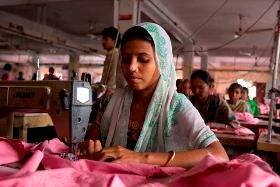
Are these good economics and good politics now and in the future?
As economists we know, in most situations, unions create economic distortions by pushing the wages of their members up relative to non-unionized employees. Such wage increases have asymmetric impact on labor—the insiders benefit and the outsiders lose out. Unions may also create other distortions like discouraging employers from adopting certain technologies and efficiency-enhancing practices. On these grounds, reducing the power of unions is often mainstream economic advice. The counterarguments rooted in economic theory typically refer either to the role of unions in securing a more equal distribution of income, especially by improving the pay of lower-grade workers, or to counterbalance the monopsony power firms may have in setting wages.
Any policy choice that increases the ability of unions to push for high wages and better working conditions, even if it does not directly make it easier to organize unions, will indirectly increase union activity. Many workers may find joining unions worthwhile when the premium they receive is increased. Today’s policies affect tomorrow’s organizational investments and thus the distribution of political power, in this case the power of unions. In the garments status quo, the balance of power is already tilted in favor of large employers so that strengthening unions might create a less tilted balance of political power in the industry and, for that matter, the society at large, with the potential dynamic benefits that this may engender.
Going beyond just fighting for higher wages or attempting to influence the internal organization of firms, unions have also been very active politically in ways that seem to affect the political balance. One of the most important consequences of the political power of unions is the role they play in creating and supporting democratic institutions around the world, particularly starting from a situation in which political power is very unequally distributed. One strand of thinking on the factors influencing the creation of democracy has moved away from emphasizing the role of the middle class or the bourgeoisie alone to that of the working classes who have often played a defining role in the emergence of democracy. The extent to which the working class is able to engage in collective action is critical for its ability to push for institutional change. Since unions are in the business of organizing working people, it makes sense that the presence of unions should facilitate collective action that pushes for regime change in favor of inclusive development.
Policies increasing the effectiveness of unions in negotiating over wages and working conditions for their members will increase their political power. The evidence suggests that such increases in their political power increase unionization rates. If the political power of unions is important in supporting a range of other economic and political outcomes, then implanting some “labor market failures” associated with union-induced high wages may front fire. Such policies will then constitute good economics no matter what the economics textbooks say.
Remember history teaches us good economics is not always good politics.
A key question therefore is whether strengthening unions in garments is in the interest of existing political power groups. Politicians are often constrained by their own incentive compatibility constraints. These determine the expected benefits that a political leader in power must obtain for oneself or give to organized interests, such as the various garments manufacturers’ associations, if he or she wishes to stay in power.
Strengthening unions, without recognizing and addressing the fundamental political and institutional sources of ineffective unions, may violate these constraints. In other words, a set of policies which may seem deeply well guided by the standards of current international practices may nonetheless fail to serve the political economy purpose of holding together a governing coalition. Introducing such policies can weaken existing coalitions. The result may be the rise of new coalitions which reinstate the failures the policy is intended to correct, or create new ones, because they are useful in binding together the governing coalition. This type of recreation has been dubbed the seesaw effect.
Having said that, as experienced in Bangladesh’s garments recently, the results of maintaining status quo is a period of frequent labor unrest, with high costs of its own, or even a collapse of the industry in future. Only time will tell whether or not surfacing of these present and future costs have been a game changer. The confluence of impending political transition in Bangladesh and renewed international pressure for compliance with improved labor standards makes support for empowering the 4 million workers in garments good politics for now. This presents a real opportunity for changing the game. Whatever measures the government and the industry implement under domestic and international pressure, the enforcement and commitment to ensure better and safer practices now will be critical for the future as these processes often tend to be path dependent. Once in place they become hard to reverse.
Stronger labor unions may be a catalyst or hindrance to transforming working conditions and industrial relations in the garment industry. They will be a catalyst if they are able to act as an autonomous countervailing power working in the legitimate interests of labor. They will be a hindrance if they regress to become just an extension of the pre-existing industrial order that de-facto limited the ability to form workers associations only to members of the coalition and tied the interests of labor elites directly to the survival of the pre-existing order, thus ensuring their continued cooperation. Addressing policy failures in this setting without appropriate consideration of political consequences may be ineffective or even counterproductive in broad social terms characterized by poor working conditions, a small number of unions and worker associations along party lines with privileges, unequal enforcement of laws, and insecure labor rights.


Join the Conversation